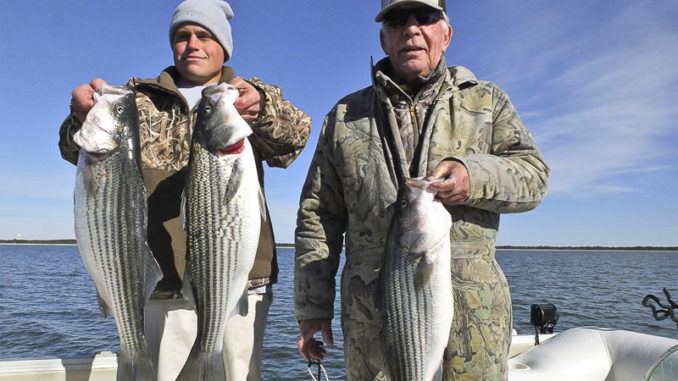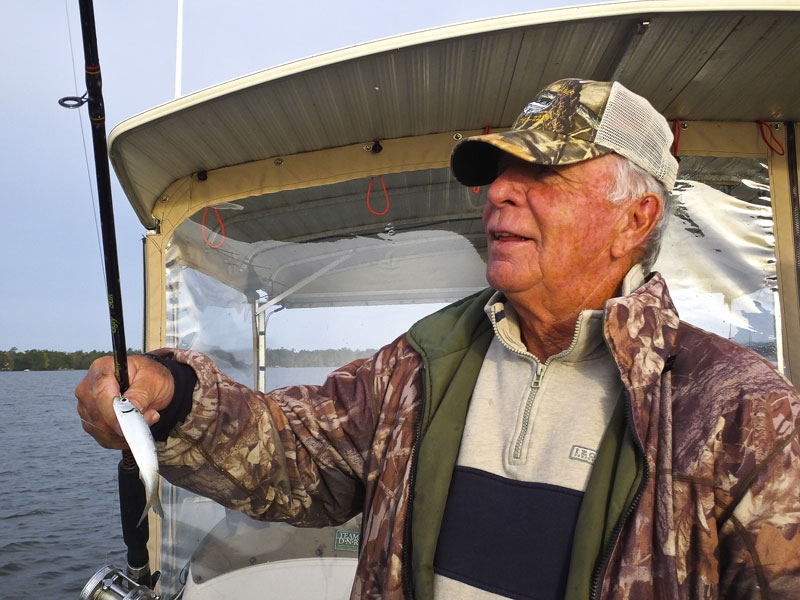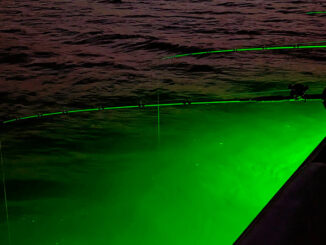
Latest regulation showing good, early results
As opening days for fishing seasons go, the opening of the Santee Cooper striper fishing season on Oct. 1 ranks high and is eagerly anticipated by anglers.
The striper fishing was absolutely wild last October, despite unseasonably hot weather. The heat didn’t slow the activity. Guide boats and other anglers caught and released scores of stripers, while often keeping limits of fish within the legal slot limit.
Stripers on Lures
Bobby Winters, who guides out of Blacks Camp, said that while some surface schooling activity occurs early and late in the day in early October, the best is yet to come, later in the month and through November.
“But the good news is that stripers are schooled up in big bunches and are very active,” he said. “Even if they’re suspended and not schooling on the surface in early October, we’ll spot them on the graph and can use different artificial lures to catch them. White bucktails in 1/2- to 1-ounce sizes are always an excellent choice. And spoons jigged at the depths fish are marked on the graph are another highly productive option.”
On a trip with Winters early last October, we jigged LiveTarget spoons to catch multiple stripers in and around the 23- to 25-inch slot limit. We also caught a few bigger than 26 inches — one fish that size is allowed per day. The early October action is usually fast-paced. Multiple anglers are often hooked up at any given time.
Stripers were also surface schooling in the late evenings and were highly susceptible to these same artificial offerings.
Winters (843-751-3080) said Lake Marion and Lake Moultrie are full of stripers in the slot limit. And using the graph is the key to finding the stripers when they aren’t feeding on the surface.
Live Bait is Lethal
If you’re not into slinging artificial lures, the live-bait fishing for stripers is also excellent during the entire fall. And that bite lasts from opening day through the end of the calendar year.
Guide Leroy Suggs often prefers artificial lures early in October. But he said having plenty of blueback herring is never a bad idea.
“Forage is highly abundant in October. And stripers are feeding heavily, making the use of artificial lures very productive,” Suggs said. “The air is usually cooler in October, but the water is still warm. And the striper bite is usually aggressive.”
Suggs (910-995-1168) said fishing live herring, suspended at the depth fish are marked on the graph, is productive.
“Live bait or artificial lures will get you hooked into some great striper action once you find the fish,” Suggs said.

Striper Regs Work
Levi Kaczka, regional fisheries biologist for the S.C. Department of Natural Resources, said the agency is happy with what is happening with the striper population in the Santee Cooper system.
“After two full seasons with the new regulations, we gathered enough data to see some trends,” he said. “Our catch rates from the past two seasons have been among the highest since the early 2000s.
“Another good sign is we’re seeing older fish as well. The proportion of older fish in our sample (6 to 8 years) has increased the past two years. One of the goals of the most-recent regulation change was to balance the need to keep fish in the system long enough to reach maturity and have the chance to spawn, while also providing the opportunity to catch harvestable size fish.”
Kaczka said, based on the last two years of data, only about 4% to 5% of the annual catch was of a size that anglers could harvest under the previous, 26-inch size minimum. Under our current regulations, 15% to 25% of the annual catch is of a harvestable size. So, knowing we’re keeping fish in the system longer, while also seeing large increases in the numbers of harvestable-sized fish, is a positive.
Stocking plays a big role
“We’ve come to realize our hatchery system plays a large role in the Santee Cooper striper fishery,” he said. “We typically request about 2.5 million striper fry to be stocked each year in Marion and Moultrie. There were concerns about meeting this request with all the COVID-related shutdowns in the middle of the hatchery season. But our hatchery folks were able to produce and stock 2.4 million fry between the two lakes. This 100K difference between the request and final number isn’t anything more than the normal year-to-year variability with stocking. We didn’t miss a beat, despite the logistical constraints COVID has imposed.”
Kaczka said with the current regs being in effect for just two full seasons, SCDNR will continue monitoring for any trends. But so far, those regulations seem to be having a positive effect on both the fish and the fishing.



Be the first to comment